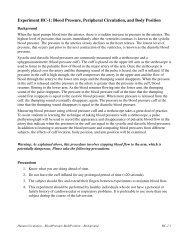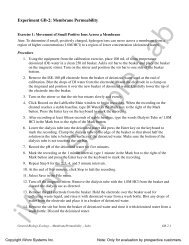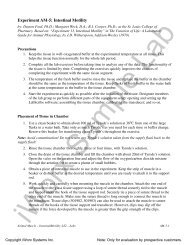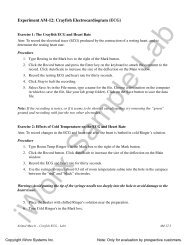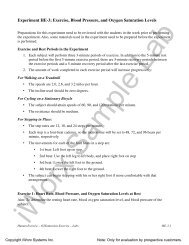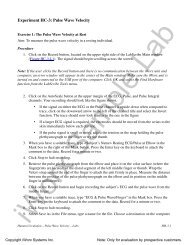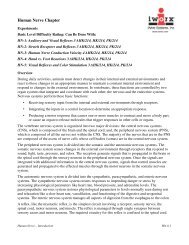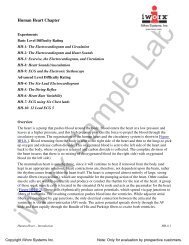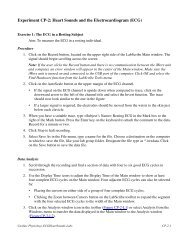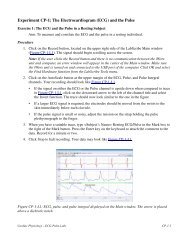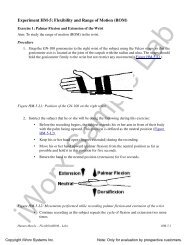Experiment RP-2: The Effect of Gravity on Breathing - iWorx
Experiment RP-2: The Effect of Gravity on Breathing - iWorx
Experiment RP-2: The Effect of Gravity on Breathing - iWorx
- No tags were found...
Create successful ePaper yourself
Turn your PDF publications into a flip-book with our unique Google optimized e-Paper software.
Figure <str<strong>on</strong>g>RP</str<strong>on</strong>g>-2-L2: <str<strong>on</strong>g>The</str<strong>on</strong>g> LabScribe toolbar.3. Click <strong>on</strong> the Analysis window ic<strong>on</strong> in the toolbar (Figure <str<strong>on</strong>g>RP</str<strong>on</strong>g>-2-L2) or select Analysis from theWindows menu to transfer the data displayed in the Main window to the Analysis window(Figure <str<strong>on</strong>g>RP</str<strong>on</strong>g>-2-L3).4. Look at the Functi<strong>on</strong> Table that is above the uppermost channel displayed in the Analysiswindow. <str<strong>on</strong>g>The</str<strong>on</strong>g> mathematical functi<strong>on</strong>s, V2-V1 and T2-T1 should appear in this table. Values forV2-V1 and T2-T1 <strong>on</strong> each channel are seen in the table across the top margin <str<strong>on</strong>g>of</str<strong>on</strong>g> each channel.5. Minimize the height <str<strong>on</strong>g>of</str<strong>on</strong>g> the Air Flow channel by clicking <strong>on</strong> the arrow to the left <str<strong>on</strong>g>of</str<strong>on</strong>g> the channel’stitle to open the channel menu. Select Minimize from this menu to reduce the height <str<strong>on</strong>g>of</str<strong>on</strong>g> thechannel display.6. Maximize the height <str<strong>on</strong>g>of</str<strong>on</strong>g> the trace <strong>on</strong> the Volume channel by clicking <strong>on</strong> the arrow to the left <str<strong>on</strong>g>of</str<strong>on</strong>g>the channel’s title to open the channel menu. Select Scale from the menu and AutoScale fromthe Scale submenu to increase the height <str<strong>on</strong>g>of</str<strong>on</strong>g> the data <strong>on</strong> that channel.7. Once the cursors are placed in the correct positi<strong>on</strong>s for determining the volumes <str<strong>on</strong>g>of</str<strong>on</strong>g> each breathcycle, the values <str<strong>on</strong>g>of</str<strong>on</strong>g> the parameters in the Functi<strong>on</strong> Table can be recorded in the <strong>on</strong>-linenotebook <str<strong>on</strong>g>of</str<strong>on</strong>g> LabScribe by typing their names and values directly into the Journal.8. <str<strong>on</strong>g>The</str<strong>on</strong>g> functi<strong>on</strong>s in the channel pull-down menus <str<strong>on</strong>g>of</str<strong>on</strong>g> the Analysis window can also be used to enterthe names and values <str<strong>on</strong>g>of</str<strong>on</strong>g> the parameters from the recording to the Journal. To use thesefuncti<strong>on</strong>s:• Place the cursors at the locati<strong>on</strong>s used to measure the volumes <str<strong>on</strong>g>of</str<strong>on</strong>g> the breath cycle.• Transfer the names <str<strong>on</strong>g>of</str<strong>on</strong>g> the mathematical functi<strong>on</strong>s used to determine the volumes to theJournal using the Add Title to Journal functi<strong>on</strong> in the Volume Channel pull-down menu.• Transfer the values for the volumes to the Journal using the Add Ch. Data to Journalfuncti<strong>on</strong> in the Volume Channel pull-down menu.9. On the Volume channel, use the mouse to click <strong>on</strong> and drag the cursors to specific points <strong>on</strong> therecording to measure the following volumes:• Tidal Volume (TV), which is the volume <str<strong>on</strong>g>of</str<strong>on</strong>g> air inhaled or exhaled during a normal breathingcycle. To measure the tidal volume <str<strong>on</strong>g>of</str<strong>on</strong>g> the subject during breathing at rest, place <strong>on</strong>e cursorin the trough prior to inhalati<strong>on</strong>, and the sec<strong>on</strong>d cursor <strong>on</strong> the peak <str<strong>on</strong>g>of</str<strong>on</strong>g> the cycle. <str<strong>on</strong>g>The</str<strong>on</strong>g> valuefor the V2-V1 functi<strong>on</strong> <strong>on</strong> the Volume channel is the tidal volume.(Figure <str<strong>on</strong>g>RP</str<strong>on</strong>g>-2-l3).• Breath Period, which is the durati<strong>on</strong> <str<strong>on</strong>g>of</str<strong>on</strong>g> each breathing cycle. To measure the breath period<str<strong>on</strong>g>of</str<strong>on</strong>g> the subject during breathing at rest, place <strong>on</strong>e cursor <strong>on</strong> a peak <str<strong>on</strong>g>of</str<strong>on</strong>g> a breath cycle, and thesec<strong>on</strong>d cursor <strong>on</strong> the peak <str<strong>on</strong>g>of</str<strong>on</strong>g> an adjacent cycle. <str<strong>on</strong>g>The</str<strong>on</strong>g> value for T2-T1 <strong>on</strong> the Volume channelis the period <str<strong>on</strong>g>of</str<strong>on</strong>g> that breath cycle (Figure <str<strong>on</strong>g>RP</str<strong>on</strong>g>-2-L4).10. Record the values in the Journal using the <strong>on</strong>e <str<strong>on</strong>g>of</str<strong>on</strong>g> the techniques described in Steps 7 or 8.11. Repeat the measurements <str<strong>on</strong>g>of</str<strong>on</strong>g> tidal volume and breath period <strong>on</strong> two additi<strong>on</strong>al normal breathcyclesRespiratory Physiology-<str<strong>on</strong>g>Gravity</str<strong>on</strong>g><strong>Breathing</strong>-Labs<str<strong>on</strong>g>RP</str<strong>on</strong>g>-2-4



